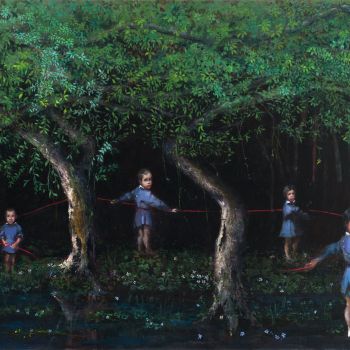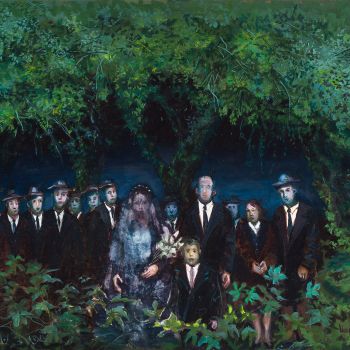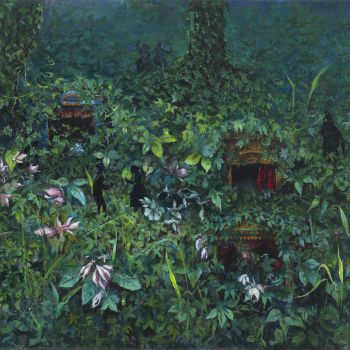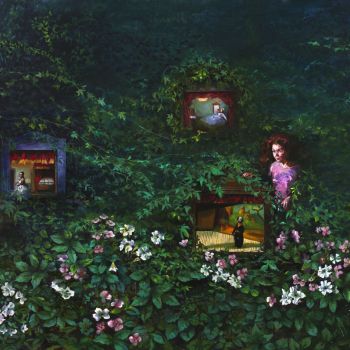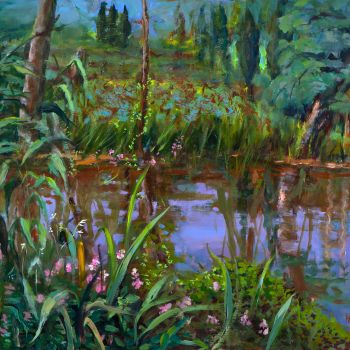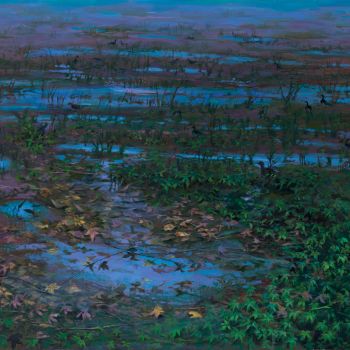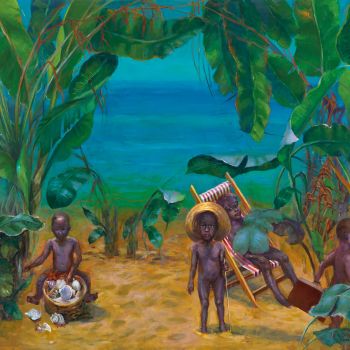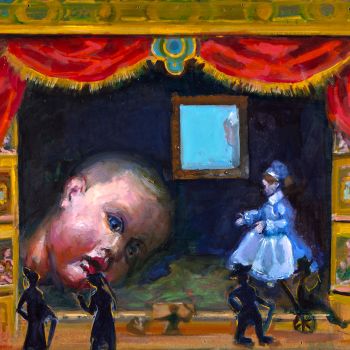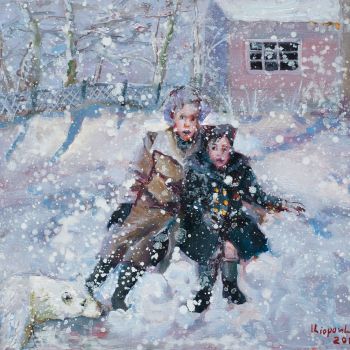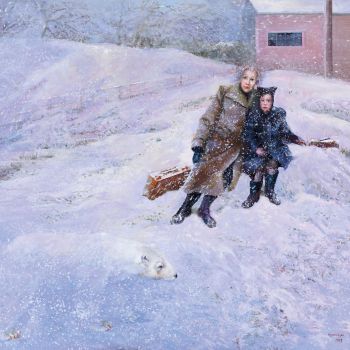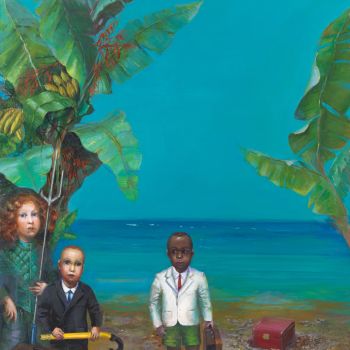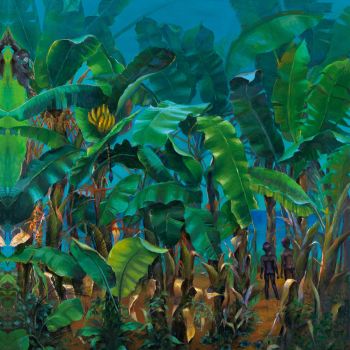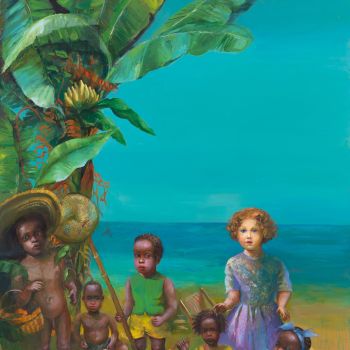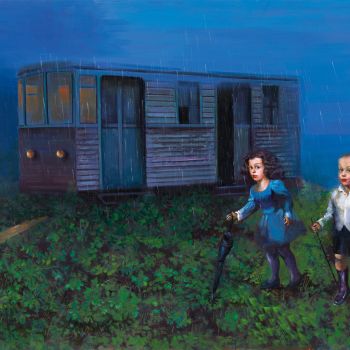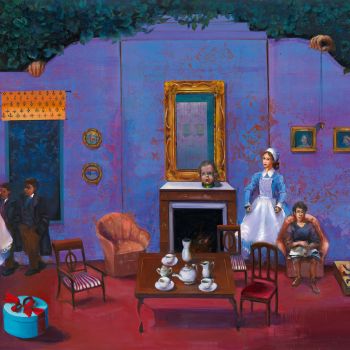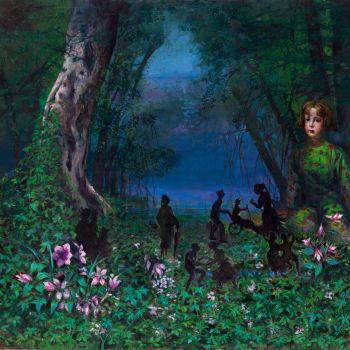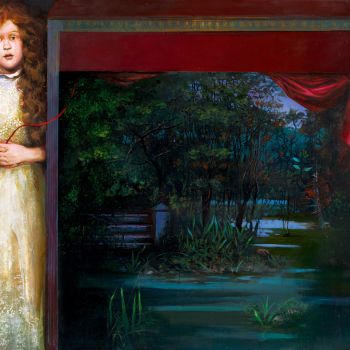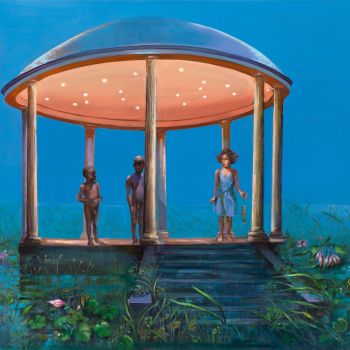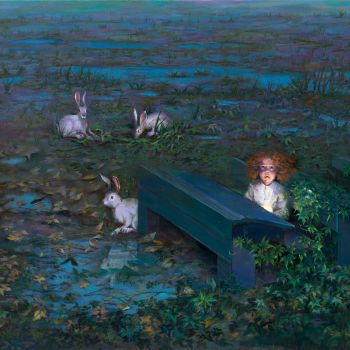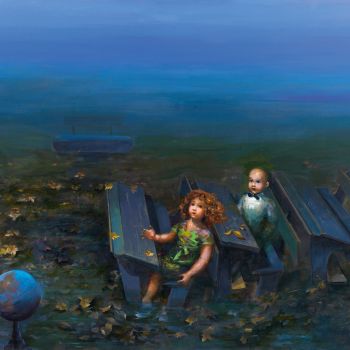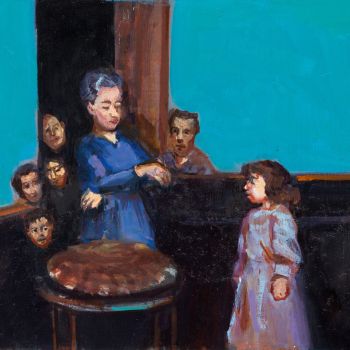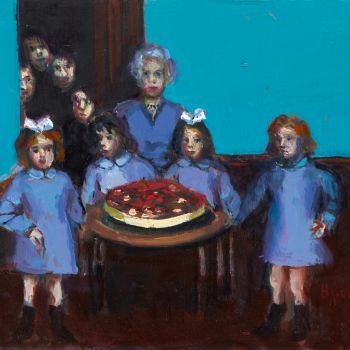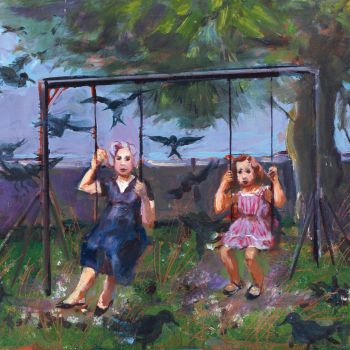Irini Iliopoulou’s last exhibition, Small Tropics (2009), featured imaginary voyages and oneiric escapades in which the protagonists were all school-aged children. The paintings were born of a lengthy gestation, a long period of soul-searching in the wake of wrenching personal loss. Recovering remembrances and reimagining her childhood years was a kind of recreation of her history.
The present suite of paintings consequently concerns a re-invention of the self, a re-definition of the persona of the artist and the woman as an individual. In her most recent paintings Iliopoulou explores an iconography of the feminine psyche: baby dolls, puppets, costumes, cherubs, vestal virgins, divas, prophetesses, sirens… In the same vein, she depicts loci of feminine longing: the static irreality of mirage-like tropical beaches and blue lagoons as well as sunken forests densely overlaid in vines and shrubbery. These are fantasized escapes-landscapes or secret dwellings of the mind – places for retreat and sanctuary (as were her Cafés of 2006). The corpus of the current exhibition consists of large-scale works depicting scenes outside in nature where the dominant hue is blue. These major pieces are accompanied by an ensemble of smaller semi-autobiographical works portraying ‘parlor scenes’, gatherings, festivities – a dolls’ tea party, a holiday parade with sinisterly hooded celebrants; a funerary procession of fedora’d mafiosi in a forest clearing, led by a bride with bouquet whose doll face is blurred by her wedding veil; a cluster of artist’s jointed mannequins peering through the leaves at a foreshortened central figure, some impish woodland sprite who’s removed the perforated door of his torso so we can see the spring within. He wears a conical dunce cap and faces off with the viewer while the others strain beady-eyed to watch the show (‘little shop of horrors’) and are eerily inexpressive like the possessed children of horror movies. Along with curiosity, there’s a shiver of revulsion: mannequins and antique dolls frighten because of their uncanny resemblance to a living human being and an anonymous corpse.
Yet there’s a clamor of color that adds playfulness to the picture Dolls where all the little women resemble their progenitor, giving this parlor game a specular dimension (a mirror hangs above the mantel to reiterate the effect). Furthermore, the daintily dressed dolls grace a décor that’s so garishly smeared in pink it could be a brothel. In the present show, as always, Iliopoulou puts provocation and ambiguity to painterly use. It’s her fancy to combine disparate references and associations, to exploit incongruities (ie. funeral and wedding all in one procession or hooded penitents flanking mother and toddler in the same parade; some dolls have glass eyes while others bear vacant sockets; the feral menacing look on some of the cherub’s faces inspired by the putti of Medieval Spanish wooden statuary…).
Romps, trysts, revels, rites find the perfect setting in the woods. Concealed by shadowy light, covered from the treetop canopy above, insulated on all sides with the ground carpeted in ferns and vine, it is the ideal place to hide. Thus the theater boxes on the forest floor evoke the pageant wagons of medieval drama, with ivy overhanging like a curtain above the cavernous apertures of their ornate stage frames. Silhouette cutouts suggest shadow puppets improvising off-stage. No human presence here to interfere in the painting Theatersbut an avatar of the artist will appear in the partner to this piece, Operas, where the theater boxes glow in the forest, each individual stage alight with a different opera heroine in the raptures of song. Illuminated, the painter revels in this private performance of the voice exalting passionate love – for isn’t sublimation a form of projection as well? They are miniatures but no strings, sticks or hands appear to be operating the marionettes.
In Theaters the ornate boxes (treasure chests) lay hidden in the woods like toys left behind by revelers – a trail to be discovered. The black cutouts animate the space in their burlesque jubilance: Punch and Judy doing a jig, Mary Poppins landing with her magical umbrella, a girl and a captain quarreling. In their turn, the shadow puppets are imbued with color and spirit to perform as divas in Operas. The floral accents of pink in the foreground of the woodland scenes lend a note of false harmony – their prettiness contrasting boldly with the blue-green vegetation glutting the background. Likewise, we find the decapitated heads of baby dolls strewn in the underbrush. The tentacles of ivy tinted with gold spindle out toward the figure implying entanglement. This self-portrait, or epiphany, features a figment of the artist in an enchanted woods surrounded by three miniature opera boxes, each one contains a cantatrice: Violetta of La Traviata, Mimì of La Bohème, Cio-Cio San of Madame Butterfly. The heroines are like so many identifications, muses or idealizations of the Self. Each figure personifies sublime self-sacrifice yet all three protagonists die unfulfilled, victims of star-crossed love.
In her other autobiographical portrait, the mesmerizing Maenad’s Playthings, the artist renders herself in the role of Daphne who, according to Ovid, metamorphosed into a tree to escape Apollo’s rapturous pursuit. Here the female body is covered in snakelike vines of ivy that look parasitical. From her hand drops a blood-stained string with a porcelain head pendant while other childlike mannequins slump against her trunk; livid puppets dangle headless from the tree behind – where dislocated members like prostheses also hang in supernatural suspension. The eye catches on the congruence of rosy petals and the prominent areola as well as the phallic tip of the artificial limbs pulled from their sockets. We are riveted by the statuesque serenity of this nymph on her way to petrification. The stony resolve freezing her features is almost Amazonian. It denotes the final defiance – the preservation of her purity – before she is fixed forever in unyielding bark.
The ‘doll children’ have an unreality, a stiffness that is evocative of death. The wooden rigidness of their gestures recalls the macabre undertones of silent pantomimes and maudlin circus clowns who both attract and repulse due to the unconscious association with death’s frozen inanimateness. In folktales the lifeless are infused with spirit, the dead called back to life. Just as the painting echoes Euripides’ Bacchae who tore Pentheus to pieces while they were in the throes of Dionysiac frenzy, Irini’s bacchante bears the shades of Shakespeare’s Orphelia and Titania. The figure here is far from frantic and to the contrary seems to be moving in a trance. In the lull of aftermath, she strings together the disjointed members of mannequins, her palms printed crimson. She suspends the puppets (rendered on the same scale as the human is drawn) from the boughs of the tree behind her, a kind of ritual hanging. One’s torso is bandaged while white light threads through the ivy vines. Her solemn resignation suggests that she is in the throes of metamorphosis: once the transformation is complete, she will be forever an arbor sentinel. The impassiveness of her countenance also brings to mind a ship’s wooden figurehead, some somber siren staring out to sea.
This work places itself under the protection of the cult of the Virgin or of the huntress Diana. “Dear father, grant me while I live my maidenhead for to have, As to Diana heretofore her father freely gave’” implores Daphne in Ovid’s Metamorphoses (1.588-9). Shakespeare’s heroines are touched by folly (Orphelia, spurned and aggrieved, and Queen of the Fairies, Titania, blindly impassioned by an elixir) whereas Daphne, certainly as Iliopoulou has pictured her, bears herself with the gravity of a priestess or a seer (Iphigenia, sacrificed daughter, and Cassandra come to mind). Here symbolism is superposed like foliage to be foraged for hidden treasures.
In the painting Swings hammocks spun like chrysalises hang between sinewy silt-black trees. Against the backdrop of blue forest, they resemble cocoons and an eerie foreboding looms in the uninhabited landscape. The trees are so thick with vines they appear hollow – their eyes are watching ours. We glimpse the mist in the buoyant mauve background. Winter is also a barren scene, a wetland devoid of figures where we find instead silhouetted fowl, a phantom flock of ducks ominously stark against a darkening azure field. A tourbillion of fallen leaves draws the gaze to the painting’s center. Bitter Orange Trees shows a trio hands linked winding around a tree in a ring dance. The initiates appear to be led by the girl with luminous skin in a camisole. Their surprise at being seen underscores the erotic innuendos along with the shamefaced putto caught spying on them from the trees (whose discomfort recalls the grim-faced winged-Seraphim figures of Byzantine mosaics). The dislocation of the architectural accent from place of worship to woods accentuates the theatricality of Irini’s compositions. The three children are wading in a flooded grove as moonlight reflects phosphorescently on the trees, turning oranges blue.
The woods are the location for secret rituals and the place where transformations occur in folk imagination, particularly in Celtic mythology. (In Old English, the word ‘wood’ meant ‘violently mad’). And the stages set in the forest provide the scene for the doubling or splitting of the Self. Here stage design depends on flamboyant nature that the English Romantics were so fond of painting as well. The impersonations performed by actors rejoin the metamorphosis motif. In Ovid’s stories, gods transform mortals into other living things out of vengeance, lust or wrath and occasionally, pity. Human beings are irretrievably mutated yet their lives are spared. Deities rape virgins and steal from mortals their humanity… but the morphing process can also be seen as reincarnation. Myrrha, who shared a bed with her father, is shown clemency by the gods and her shame hidden from the world once she’s turned into a tree. Thus her sorrow is contained in the bark sheath of the myrrh tree, rooted for all eternity.
This new body of works is a play on staging and pretending, one of the artist’s preoccupations since she painted in the then-abandoned theater, Vieux Colombier, in Paris from 1987-88, while her doll fetish has been manifest since her first exhibition in 1986. We’re also given the chance to revisit Irini’s ‘ecology’ where nature is not menaced but to the contrary dominates – the suffocating vegetation, strangulating vines of her magic forests where we can almost hear the leaves rustling as creatures scamper beneath. Here nature is not idealized in inert landscapes but viewed as very much alive – a camouflage for fairy mischief and amorous tussles. The objectification of the human body as represented in the form of a dummy reminds us of our mortality without being clinical. Irini’s palette is visceral, her color range luxuriant. This sequence of works also stands as a cautionary tale on the theme of endangerment. In her romantic allegory, fragile innocence is figuratively threatened by voracious vegetation. The nature she depicts is ‘fantastic’ and not representative. Beware, little children, of walking in the woods for you may be turned to stone, or into a porcelain puppet.
Irini distinguishes herself from the currently popular autobiographical trend that leans heavily on photography in that her work is at once more painterly and more disturbing because surreal, not some facsimile of reality. In her retelling of the Daphne myth uncertainty prevails: has her Maenad been punished, some lusty god avenged her refusal and unleashed his vines to consume her? Or has the maiden sworn herself to chastity, chosen to shed her corporal husk rather than be ravaged? Irini fantasizes about different manifestations of the Self and ambiguity reigns here as well: is the puppeteer a Medea figure, vengefully playing with dismembered dolls or a goddess who will breathe life back into them? The leitmotif is manipulation – be it scenic adjustments or dactyl maneuvering of stencils and puppet pawns. It is a world of make-believe where everything is manipulable, changeable. The compositions are ordered by binary oppositions: containment/overflow, concealment/exposure, enclosing/unfurling. Not only spatial juxtapositions but paranormal occurrences punctuate the tableaux: bewitching, shape- shifting, dissections, doubles, impersonations, hybrids, apparitions… as well as a confoundingly Carrollian sense of disproportion. These are some of the tropes by which Irini Iliopoulou explores the expanse of the psyche. By inverting the natural order she exposes the lining, proposes an alternative reality, and our eyes open wide at the suggestion.
Andrea Schroth
October 2011


